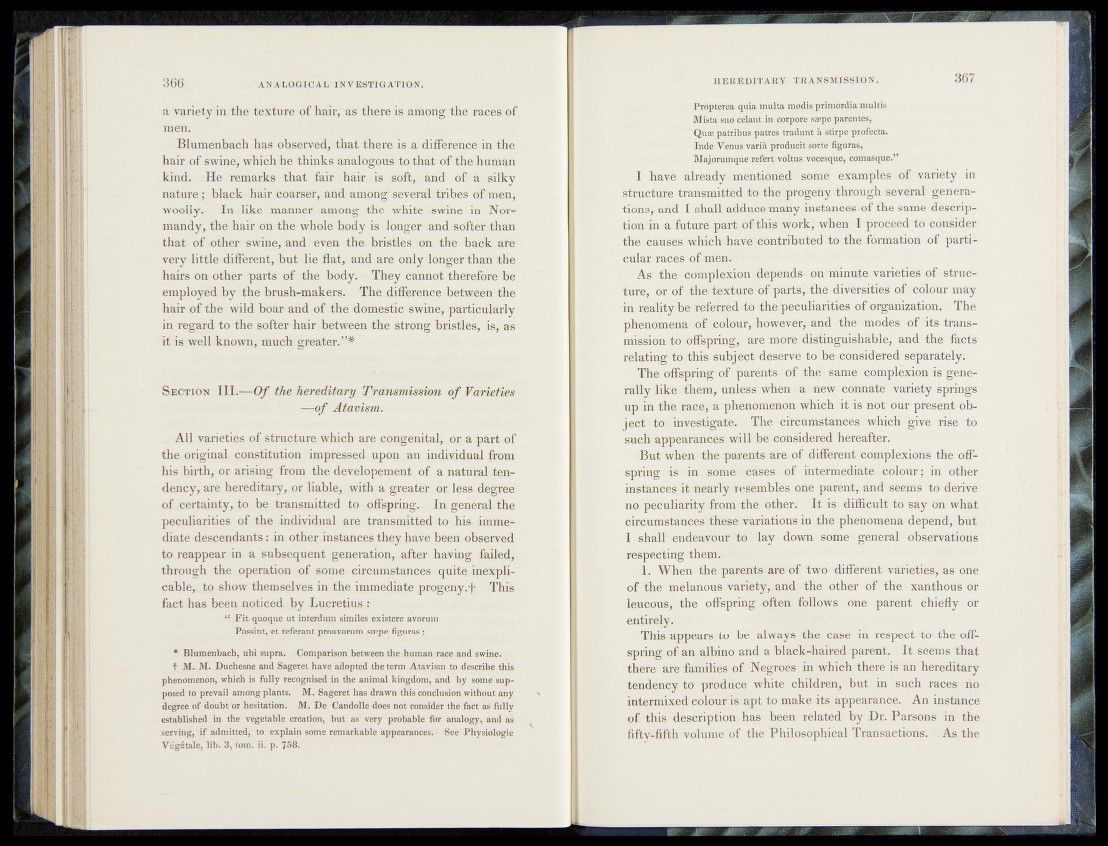
a variety in. the texture of hair, as there is among the racks of
men.
Blumenbach has observed, that there is a difference in the
hair of swine, which he thinks analogous to that of the human
kind. He remarks th a t fair; hair *is soft, and of a silky
nature; black hair coarser,andambn^ several tribes of men,
woolly. In like manner among the white swine in Normandy,
the hair .agp the whole body is longer and softer than
that of other swine, and even the bristles on the back are
very little different, but life flat, and are only longer than the
hairs on other 'parts of the body. • They cannot therefore be
employed by the brush-makers.. The difference between the
hair of the wild boar and of the'domestic swine, particularly
in regard to the softer hair between the strong bristles, is; as
it is well known, much greater.”*
S e c t io n I I I .— O f the hereditary Transmission o f Varieties
—o f Atavism. ■.
All varieties of structure which are congenital, p r a part of
the original constitution impressed upon an individual from
his birth, or arising from the developgment of a natural tendency,
are hereditary, or liable, with a greater or less degree
of certainty, to be transmitted to offspring. In general* the
peculiarities of the individual are transmitted to his* immediate
descendants : in other instances they have been observed
to reappear in à subsequent generation, after having failed,
through the operation of some circumstances quite inexplicable,
.to show themselves in the immediate progeny.f This
fact has been noticed.by Lucretius-:
‘‘ . F it quoque ut interdum similes existere avorum
Possint, et référant proavorum sæpe figuras ;
* Blumenbach, ubi supra. Comparison between the human race and swine.
+ M. M. Duchesne and Sageret have adopted the term Atavism to describe this
phenomenon, which is fully recognised in the animal kingdom, and by some supposed
to prevail among plants. " M. Sageret has drawn this conclusion without any
degree of doubt or hesitation. M. De Candolle does not consider the fact as fully
established in the vegetable creation, but as very probable for analogy, and as
Serving, if admitted, to explain some remarkable appearances. — See Physiologie
Végétale, lib. 3, tom. ii, p. Jôïi.
Propterea quia multa nciodis primordia multis
Mista s.uo. c.elaut, in corpore sæpe parentes,
" Q'uæ patçilras pâtres tradunt à stirpe piofecta.
Inde Vends variâ producit sorte figuras,
Majorumque refert voltus vocesque, comasque.”
I have ' already^mentioned «sdnîè examples ©f variety in
structure transmitted to the,progeny through several genera-
tions^and I shall addijul^tnatiy instances of the same description
in alfâture part o f this1 Work' when I ■proceed to consider
the causes which have^éontributed- to the formation of parti-
cufet rates of men: >
' - AsWftie’complexion 'dépendis- on minute varietilfc af structure,
tori o f tlieHextUfe of parts, the diversities of colour may
in reality be referred to the peculiarities of organization. The
phenomena of colour, however^and >thè <modes of its trans-
mission’to offspring, are m i ^ «‘distinguishable, and the facts
relating to this subject deserve to.be considered separately.
The offspring of parents > of the same complexion is generally
like them, unless when a new connate variety springs
up in the race, a phenomenon which it is* not our present object
to investigate: | The circumstances which give rise to
such appearances will be considered hereafter:
But when the parents are of different complexions the offspring
. is in some cafses of intermediUte^edlour ; in other
instanceg.it nearly resembles one pdifetït," and seems ‘to derive
no« peculiarity- from the other. It is difficult to say on what
circumstances these variations in the phenomena, depend, but
I shall endeavour to lay down some general observations
respecting them.
1 . When the parents are of two different varieties, As one
of the melanous variety, and the other of the - xanthous or
leucous, the offspring often follows one parent chiefly or
entirely.
This appears to be always the case in respect to the offspring
of an albino and a black-haired parent. It seems that
there are families of Negroes in which there is an hereditary
tendency td' produce white children, but in such races no
intermixed colour is apt to make its appearance. An instance
o f this description has been related by Dr. Parsons in the
fifty-fifth volume of the Philosophical Transactions. As the